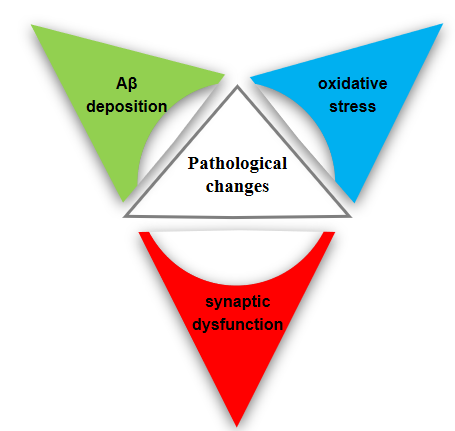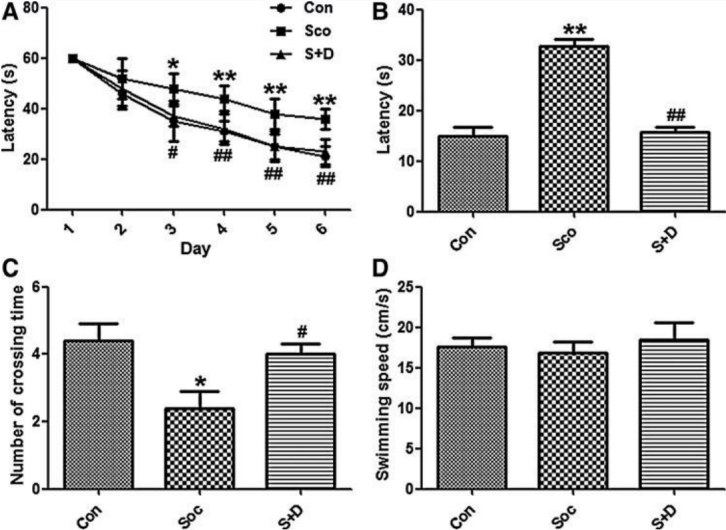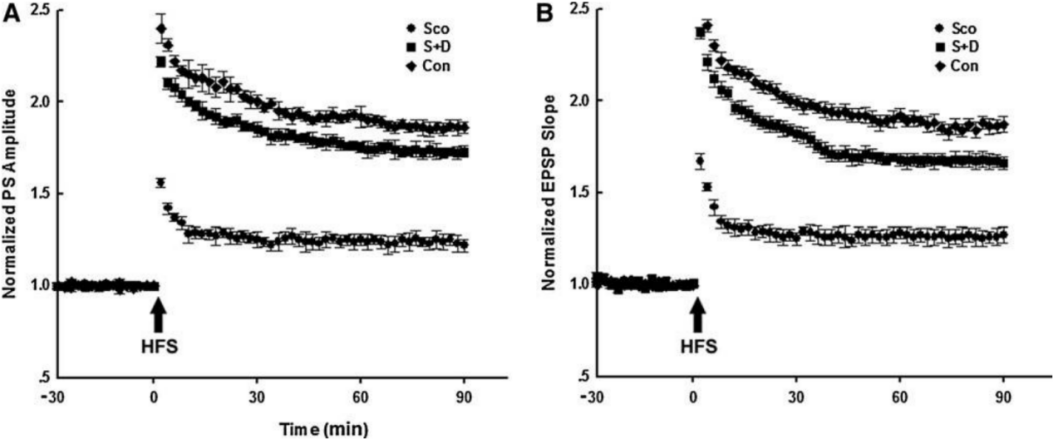Scopolamine Induced Model
Scopolamine is a non-selective muscarinic receptor antagonist that impairs spatial learning and memory abilities by blocking cholinergic signaling as well as some possible indirect effects. It is one of the commonly used drugs in chemical-induced Alzheimer's disease model. For example, rat dementia is usually induced by intraperitoneal injection for two weeks (1mg/kg).
 Figure. 1. Pharmacological changes of scopolamine-induced AD model
Figure. 1. Pharmacological changes of scopolamine-induced AD model
Creative Bioarray has many years of experience in the field of Alzheimer's disease and provides pharmacodynamic services for customers to help them assess the efficacy of compounds and study the associated pathological mechanisms of Alzheimer's disease through scopolamine induced model.
Our Capabilities
- We can provide comprehensive behavioral and cognitive testing on AD model and the drug screening.
- We can utilize LTP (long-term potentiation) assay to evaluate your preclinical drug candidates against the synaptic impairments in animals.
- We can evaluate anti-oxidative stress in the hippocampus of animals treated with drug candidates.
- We can evaluate various biomarkers through WB, IHC, ELISA, sequencing, etc.
Assays available
- Learning and memory deficits tests
- Synaptic impairment
- Oxidative stress
- Neuroinflammation
- Phosphorylated tau
- Glycogen synthase kinase-3 beta (GSK3β)
- Neurofilament Light Chain levels
- Neuronal loss
- β-AP level
- Plaque load
- β-sheet load
- pE(3)-Aβ load
- Enzyme activity related to cholinergic system
- NMDA receptor function and excitotoxicity
- Mitochondrial dysfunction
- Brain slice staining and synaptic electrophysiology
- Blood brain barrier homeostasis
- Cerebral vascular angiopathy (CAA)
With years of experience in AD research field, Creative Bioarray understands how to help design the studies to obtain rapid and clear answers to meet our customers’ need. Our in vivo animal models are capable of providing a rapid screening of the neuroprotective potential agents for the treatment of AD.
Study examples
 Figure. 2. 7,8-Dihydroxyflflavone (7,8-DHF) attenuated scopolamine-induced learning and memory defificits. (A) Latency of the rats to find the platform during the training section. Latency (B) and crossing time (C) of the rats on the 7th day. (D) Swimming speed of all groups. (*) p < 0.05, (**) p < 0.01 versus the control (Con) group, (#) p < 0.05, (##) p < 0.01versus the scopolamine (Sco) group. S + D, Sco + 7.8-DHF.
Figure. 2. 7,8-Dihydroxyflflavone (7,8-DHF) attenuated scopolamine-induced learning and memory defificits. (A) Latency of the rats to find the platform during the training section. Latency (B) and crossing time (C) of the rats on the 7th day. (D) Swimming speed of all groups. (*) p < 0.05, (**) p < 0.01 versus the control (Con) group, (#) p < 0.05, (##) p < 0.01versus the scopolamine (Sco) group. S + D, Sco + 7.8-DHF.
 Figure. 3. 7,8-Dihydroxyflflavone (7,8-DHF) reversed scopolamine (Sco)-induced synaptic impairments. (A) Normalized population spike (PS) amplitude. (B) Normalized excitatory postsynaptic potential (EPSP) slope. S + D, Sco + 7.8-DHF; Con, control; HFS, high-frequency stimulation.
Figure. 3. 7,8-Dihydroxyflflavone (7,8-DHF) reversed scopolamine (Sco)-induced synaptic impairments. (A) Normalized population spike (PS) amplitude. (B) Normalized excitatory postsynaptic potential (EPSP) slope. S + D, Sco + 7.8-DHF; Con, control; HFS, high-frequency stimulation.
Quotation and ordering
Contact us if you have any questions. Our customer service representatives are available 24hr a day.
Reference
- Veronese N et al. Association Between Short Physical Performance Battery and Falls in Older People: The Progetto Veneto Anziani Study[J]. Rejuvenation Research, 2014, 17(3):276-284.
For research use only. Not for any other purpose.
Disease Models
- Oncology Models
-
Inflammation & Autoimmune Disease Models
- Rheumatoid Arthritis Models
- Glomerulonephritis Models
- Multiple Sclerosis (MS) Models
- Ocular Inflammation Models
- Sjögren's Syndrome Model
- LPS-induced Acute Lung Injury Model
- Peritonitis Models
- Passive Cutaneous Anaphylaxis Model
- Delayed-Type Hypersensitivity (DTH) Models
- Inflammatory Bowel Disease Models
- Systemic Lupus Erythematosus Animal Models
- Oral Mucositis Model
- Asthma Model
- Sepsis Model
- Psoriasis Model
- Atopic Dermatitis (AD) Model
- Scleroderma Model
- Gouty Arthritis Model
- Carrageenan-Induced Air Pouch Synovitis Model
- Carrageenan-Induced Paw Edema Model
- Experimental Autoimmune Myasthenia Gravis (EAMG) Model
- Graft-versus-host Disease (GvHD) Models
-
Cardiovascular Disease Models
- Surgical Models
- Animal Models of Hypertension
- Venous Thrombosis Model
- Atherosclerosis model
- Cardiac Arrhythmia Model
- Hyperlipoidemia Model
- Doxorubicin-induced Heart Failure Model
- Isoproterenol-induced Heart Failure Model
- Arterial Thrombosis Model
- Pulmonary Arterial Hypertension (PAH) Models
- Heart Failure with Preserved Ejection Fraction (HFpEF) Model
-
Neurological Disease Models
- Alzheimer's Disease Modeling and Assays
- Seizure Models
- Parkinson's Disease Models
- Ischemic Stroke Models
- Acute Spinal Cord Injury (ASCI) Model
- Traumatic Brain Injury (TBI) Model
- Hypoxic-Ischemic Encephalopathy (HIE) Model
- Tourette Syndrome (TS) Model
- Amyotrophic Lateral Sclerosis (ALS) Model
- Huntington's Disease (HD) Model
- Intracerebral hemorrhage (ICH) Models
- Schizophrenia Model
- Pain Models
-
Metabolic Disease Models
- Type 1 Diabetes Mellitus Model
- Type 2 Diabetes Mellitus Model
- Animal Model of Hyperuricemia
-
Nonalcoholic Fatty Liver Disease Model
- High-Fat Diet-Induced Nonalcoholic Fatty Liver Disease (NAFLD) Model
- Methionine and Choline Deficient (MCD) Diet-Induced Nonalcoholic Fatty Liver Disease (NAFLD) Model
- Gubra-Amylin NASH (GAN) Diet-Induced Nonalcoholic Fatty Liver Disease (NAFLD) Model
- Streptozotocin (STZ) Induced Nonalcoholic Fatty Liver Disease (NAFLD) Model
- High Fat Diet-Induced Obesity Model
- Diabetic Foot Ulcer (DFU) Model
- Liver Disease Models
- Rare Disease Models
- Respiratory Disease Models
- Digestive Disease Models
-
Urology Disease Models
- Cisplatin-induced Nephrotoxicity Model
- Unilateral Ureteral Obstruction Model
- 5/6 Nephrectomy Model
- Renal Ischemia-Reperfusion Injury (RIRI) Model
- Diabetic Nephropathy (DN) Models
- Passive Heymann Nephritis (PHN) Model
- Adenine-Induced Chronic Kidney Disease (CKD) Model
- Kidney Stone Model
- Doxorubicin-Induced Nephropathy Model
- Orthotopic Kidney Transplantation Model
- Orthopedic Disease Models
- Ocular Disease Models
- Skin Disease Models
- Infectious Disease Models
- Otology Disease Models